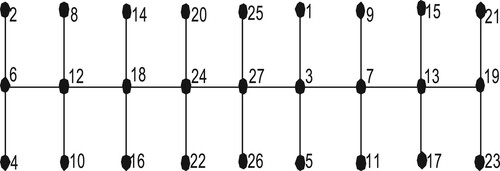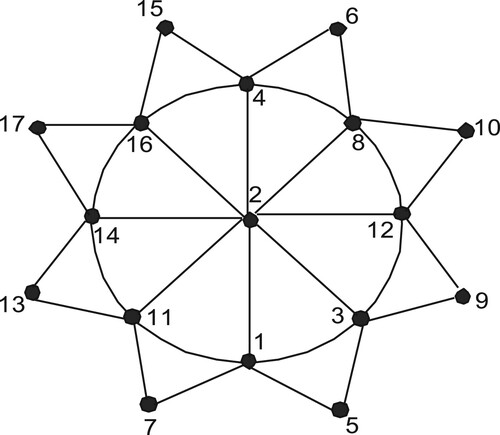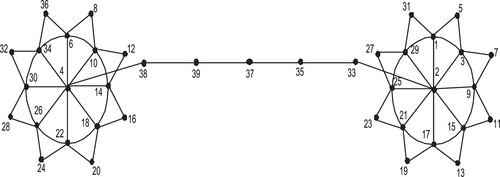 ?Mathematical formulae have been encoded as MathML and are displayed in this HTML version using MathJax in order to improve their display. Uncheck the box to turn MathJax off. This feature requires Javascript. Click on a formula to zoom.
?Mathematical formulae have been encoded as MathML and are displayed in this HTML version using MathJax in order to improve their display. Uncheck the box to turn MathJax off. This feature requires Javascript. Click on a formula to zoom.Abstract
Graph labelling is an important tool in modelling real life problems. In the present paper, different graph families are studied for prime cordial labelling. In this work, we show that the double comb graph , for
, as well as sunflower planar graph
for
, admit prime cordial labelling. We also prove that if we join two copies of sunflower planar graph by a path of arbitrary length then the resultant graph is also prime cordial.
1. Introduction
A relation between numbers and structure of graphs is called graph labelling. Graph labelings have broad range of applications in various areas of science and technology such as radar, astronomy, computer science and communication networks. Gallian [Citation1] gave a comprehensive survey of graph labelings. Cahit introduced the concept of cordial labelling [Citation2]. Many other researchers [Citation3–6] have a great contribution for deriving various results on cordial labelling.
Different labelling schemes have been introduced with minor changes in cordial labelling conditions. Motivated through the concept of prime labelling and cordial labelling, Sundaram et al. introduced prime cordial labelling [Citation7]. Prime cordial labelling contains blend of both the labelings. The present work is focused on prime cordial labelling of certain graph families.Vaidya and Vihol investigated the prime cordial labelling of graphs obtained by various graph operations [Citation8]. They also investigated prime cordial behaviour of some cycle related graphs [Citation9].
Vaidya and Shah have proved that the wheel graph and some wheel related graphs like gear, helm and closed helm graphs admit prime cordial labelling [Citation10]. Babitha and Baskar gave certain characterizations of prime cordial graphs [Citation11]. In addition to this many other researchers [Citation12–14] have great contribution for deriving characterization results on prime cordial labelling. For other studies which use similar techniques include [Citation15], [Citation16].
Every graph is not prime cordial. In this paper, we add new families of graphs to Prime cordial graphs.
These graphs correspond to many electrical, protein or communication network, and prime cordiality can help in solving the problems in different areas like coding theory, artificial intelligence, clinical psychology, radio networks and many more. In this paper we prove that double comb graph, sunflower graph and two copies of sunflower graph are prime cordial. These prime cordial graphs can, in turn, help to construct new families of prime cordial graphs by certain graph transformations.
2. Materials and methods
In this work we investigate some families of graphs for prime cordial labelling. We consider finite, simple connected graphs. Let the graph has
vertices and
edges, denoted as
.
denotes the set of vertices of graph
and
denotes the set of edges of
. We follow Gross and Yellen [Citation17] for basic graph theoretic concepts, symbols and terminology. We provide brief summary of definitions which are necessary for the present investigations.
Definition 1:
The labelling of graph is the allocation of numbers to the vertices or edges or both under certain conditions. If we assign numbers to the vertices, then the labelling is called a vertex labelling an is called an edge labelling if we assign numbers to the set of edges.
Definition 2:
A labelling is called binary vertex labelling if we assign only and
to the vertices of
i.e the range of mapping
is the set
.
Notation 1. Let be a vertex of
then
is called the label of the vertex
under
.
Notation 2. If is binary vertex labelling. Then
where
.
Notation 3. Consider the induced edge labelling defined as
, where
is an edge. Then
where
.
Definition 3:
Let be a binary vertex labelling of
then it is called cordial labelling if it satisfies the following conditions.
A graph
which satisfies the above conditions is called a cordial graph.
Definition 4:
An injective mapping is called prime labelling of
if,
, for every pair of adjacent vertices
. A graph
is termed as prime graph if it satisfies the condition of prime labelling.
Definition 5:
A bijection is called a prime cordial labelling of
if the induced edge function
defined by
such that
.
A graph with labelling satisfying above conditions is termed as prime cordial graph.
Definition 6:
A double comb graph is a graph obtained from a path by attaching two pendant vertices at each vertex of
denoted by
.
Definition 7:
A sunflower planar graph is obtained from a wheel graph with vertices
(
is central vertex and
are rim vertices) and additional vertices
such that
is joined to
and
, where
is taken modulo
.
3. Main results
Theorem 1:
Double comb graph admits prime cordial labeling for. admits prime cordial labeling for.
Proof: Let denotes double comb graph
Then
.
We define according to the following cases.
Case 1: is even.
According to the labelling scheme we have .
Case 2: is odd.
Here, we have .
So, in the two cases discussed above it can be observed that .
As a result, we can say that , labeling is elaborated in Figure .
Theorem 2:
The sunflower planar graph .
Proof: Let be the vertices of
be the edges of
We define as follows Figure ,
Case 1:
In this case, we have .
Case 2:
We can see that in this case.
Case 3:
According to this labelling scheme, .
Case 4:
Here, .
Case 5:
This labelling scheme gives .
Case 6:
By this labelling scheme, we get . So, in all the cases discussed above, it can be observed that
. Consequently, we can say that
is prime cordial for
.
Theorem 3:
The graph obtained by joining two copies of sunflower planar graph by a path of finite length is prime cordial.
Proof: Let.
Here we define the labelling function as follows.
Case 1:
Case 2:
Case 3:
Case 4:
According to the labelling scheme defined above we have .
It can be easily observed that the labelling scheme defined in each case is according to the criteria of prime cordial labelling. So, the graph is prime cordial Figure .
4. Conclusion
It is very challenging and captivating to examine whether a graph is prime cordial or not. In this paper we have contributed some new families of graphs to the family of prime cordial graphs like sunflower graph, double comb graph, sunflower graph and duplication of sunflower graph. The defined labelling schemes are demonstrated by illustrations for better perception of derived results.
It would be interesting to investigate the prime cordiality of other families of graphs by using graphical transformations of the present studied graphs.
Acknowledgement
Authors are highly grateful to reviewers for their valuable comments which helped in improvement of the article.
Disclosure statement
No potential conflict of interest was reported by the author(s).
References
- Gallian JA. A dynamic survey of graph labeling. Electron J Comb. 2009;16(6):1–219.
- Cahit I. Cordial graphs, a weaker version of graceful and harmonious graphs. Ars Comb. 1987;23:201–207.
- Babujee JB, Shobana L. Cordial languages and cordial numbers. J Appl Comput Sci Math. 2012;6(13):9–12.
- Ho YS, Lee SM, Shee SC. Cordial labelings of unicyclic graphs and generalized Petersen graphs. Congr Numer. 1988;68:109–122.
- Raj PLR, Koilraj S. Cordial labeling for the splitting graph of some standard graphs. Int J Math. Soft Comput. 2011;1(1):89–104.
- Sundaram M, Ponraj R, Somasundram S. Prime cordial labeling of graphs. J Indian Acad Math. 2005;27(2):373–390.
- Vaidya SK, Vihol PL. Prime cordial labeling for some graphs. Mod Appl Sci. 2010;4(8):119.
- Vaidya SK, Shah NH. Prime cordial labeling of some wheel related graphs. Malaya J Mat. 2013;4(1):148–156.
- Babitha S, Babujee JB. Prime cordial labeling on graphs. Int J Math Sci. 2013;7(1):43–48.
- Andar M, Boxwala S, Limaye NB. Cordial labelings of some wheel related graphs. J. Combin. Math. Combin. Comput. 2002;41:203–208.
- Ghodasara GV, Jena JP. Prime cordial labeling of the graphs related to cycle with one chord, twin chords and triangle. Int J Pure Appl Math. 2013;89(1):79–87.
- Haque KMM, Xiaohui L, Yuansheng Y, et al. Prime cordial labeling of flower snark and related graphs. Ars Combinatoria. 2012;2012(105):45–52.
- Haque KMM, Xiaohui L, Yuansheng Y, et al. On the prime cordial labeling of generalized Petersen graph. Utilitas Mathematica. 2010;2010(82):71–79.
- Seoud MA, Salim MA. Two upper bounds of prime cordial graphs. J. Combin. Math. Combin. Comput. 2010;2010:75–95.
- Marin M, Ellahi R, Chirilă A. On solutions of Saint-Venant’s problem for elastic dipolar bodies with voids. Carpathian J Math. 2017;33(2):219–232.
- Marin M, Vlase S, Ellahi R, et al. On the partition of energies for the backward in time problem of thermoelastic materials with a dipolar structure. Symmetry (Basel). 2019;11(7):863.
- Gross JL, Yellen J. Graph theory and its applications. Boca Raton (FL): CRC press; 2005.



